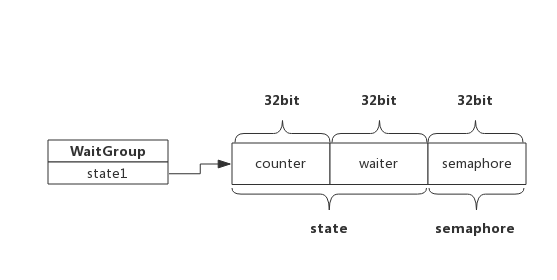Usage
To wait for multiple goroutines to finish, we can use a wait group.
This is the function we’ll run in every goroutine. Note that a WaitGroup must be passed to functions by pointer.
On return, notify the WaitGroup that we’re done.
package main
import (
"fmt"
"sync"
"time"
)
func worker(id int, wg *sync.WaitGroup) {
defer wg.Done()
fmt.Printf("Worker %d starting\n", id)
time.Sleep(time.Second)
fmt.Printf("Worker %d done\n", id)
}
func main() {
var wg sync.WaitGroup
for i := 1; i <= 5; i++ {
wg.Add(1)
// Launch several goroutines and increment the WaitGroup counter for each.
go worker(i, &wg)
}
// Block until the WaitGroup counter goes back to 0; all the workers notified they’re done.
wg.Wait()
}
Source Code
// A WaitGroup waits for a collection of goroutines to finish.
// The main goroutine calls Add to set the number of
// goroutines to wait for. Then each of the goroutines
// runs and calls Done when finished. At the same time,
// Wait can be used to block until all goroutines have finished.
//
// A WaitGroup must not be copied after first use.
type WaitGroup struct {
noCopy noCopy
// 64-bit value: high 32 bits are counter, low 32 bits are waiter count.
// 64-bit atomic operations require 64-bit alignment, but 32-bit
// compilers do not ensure it. So we allocate 12 bytes and then use
// the aligned 8 bytes in them as state, and the other 4 as storage
// for the sema.
state1 [3]uint32
}
state1是个长度为3的数组,其中包含了state和一个信号量,而state实际上是两个计数器:
- counter: 当前还未执行结束的goroutine计数器
- waiter count: 等待goroutine-group结束的goroutine数量,即有多少个等候者
- semaphore: 信号量
考虑到字节是否对齐,三者出现的位置不同,为简单起见,依照字节已对齐情况下,三者在内存中的位置如下所示:

WaitGroup对外提供三个接口:
Add(delta int): 将delta值加到counter中Wait():waiter递增1,并阻塞等待信号量semaphoreDone():counter递减1,按照waiter数值释放相应次数信号量
Add(delta int)
// Add adds delta, which may be negative, to the WaitGroup counter.
// If the counter becomes zero, all goroutines blocked on Wait are released.
// If the counter goes negative, Add panics.
//
// Note that calls with a positive delta that occur when the counter is zero
// must happen before a Wait. Calls with a negative delta, or calls with a
// positive delta that start when the counter is greater than zero, may happen
// at any time.
// Typically this means the calls to Add should execute before the statement
// creating the goroutine or other event to be waited for.
// If a WaitGroup is reused to wait for several independent sets of events,
// new Add calls must happen after all previous Wait calls have returned.
// See the WaitGroup example.
func (wg *WaitGroup) Add(delta int) {
statep, semap := wg.state()
if race.Enabled {
_ = *statep // trigger nil deref early
if delta < 0 {
// Synchronize decrements with Wait.
race.ReleaseMerge(unsafe.Pointer(wg))
}
race.Disable()
defer race.Enable()
}
state := atomic.AddUint64(statep, uint64(delta)<<32)
v := int32(state >> 32)
w := uint32(state)
if race.Enabled && delta > 0 && v == int32(delta) {
// The first increment must be synchronized with Wait.
// Need to model this as a read, because there can be
// several concurrent wg.counter transitions from 0.
race.Read(unsafe.Pointer(semap))
}
if v < 0 {
panic("sync: negative WaitGroup counter")
}
if w != 0 && delta > 0 && v == int32(delta) {
panic("sync: WaitGroup misuse: Add called concurrently with Wait")
}
if v > 0 || w == 0 {
return
}
// This goroutine has set counter to 0 when waiters > 0.
// Now there can't be concurrent mutations of state:
// - Adds must not happen concurrently with Wait,
// - Wait does not increment waiters if it sees counter == 0.
// Still do a cheap sanity check to detect WaitGroup misuse.
if *statep != state {
panic("sync: WaitGroup misuse: Add called concurrently with Wait")
}
// Reset waiters count to 0.
*statep = 0
for ; w != 0; w-- {
runtime_Semrelease(semap, false, 0)
}
}
Wait()
// Wait blocks until the WaitGroup counter is zero.
func (wg *WaitGroup) Wait() {
statep, semap := wg.state()
if race.Enabled {
_ = *statep // trigger nil deref early
race.Disable()
}
for {
state := atomic.LoadUint64(statep)
v := int32(state >> 32)
w := uint32(state)
if v == 0 {
// Counter is 0, no need to wait.
if race.Enabled {
race.Enable()
race.Acquire(unsafe.Pointer(wg))
}
return
}
// Increment waiters count.
if atomic.CompareAndSwapUint64(statep, state, state+1) {
if race.Enabled && w == 0 {
// Wait must be synchronized with the first Add.
// Need to model this is as a write to race with the read in Add.
// As a consequence, can do the write only for the first waiter,
// otherwise concurrent Waits will race with each other.
race.Write(unsafe.Pointer(semap))
}
runtime_Semacquire(semap)
if *statep != 0 {
panic("sync: WaitGroup is reused before previous Wait has returned")
}
if race.Enabled {
race.Enable()
race.Acquire(unsafe.Pointer(wg))
}
return
}
}
}
这里用到了CAS算法保证有多个goroutine同时执行Wait()时也能正确累加waiter。
Done()
Done()只做一件事,即把counter减1,我们知道Add()可以接受负值,所以Done实际上只是调用了Add(-1)。
源码如下:
// Done decrements the WaitGroup counter by one.
func (wg *WaitGroup) Done() {
wg.Add(-1)
}
Done()的执行逻辑就转到了Add(),实际上也正是最后一个完成的goroutine把等待者唤醒的。
Reference
- https://golang.org/pkg/sync/
- https://gobyexample.com/waitgroups
- https://my.oschina.net/renhc/blog/2249061
- https://memosa.cn/golang/2019/10/31/golang-waitgroup.html
- https://segmentfault.com/a/1190000021399430
- http://cbsheng.github.io/posts/%E4%BD%A0%E7%9C%9F%E7%9A%84%E4%BC%9A%E7%94%A8sync.waitgroup%E5%90%97/